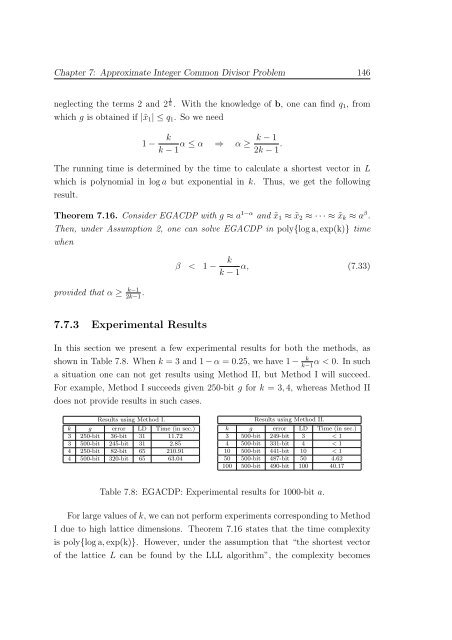Cryptanalysis of RSA Factorization - Library(ISI Kolkata) - Indian ...
Cryptanalysis of RSA Factorization - Library(ISI Kolkata) - Indian ...
Cryptanalysis of RSA Factorization - Library(ISI Kolkata) - Indian ...
Create successful ePaper yourself
Turn your PDF publications into a flip-book with our unique Google optimized e-Paper software.
Chapter 7: Approximate Integer Common Divisor Problem 146<br />
neglecting the terms 2 and 2 1 k. With the knowledge <strong>of</strong> b, one can find q 1 , from<br />
which g is obtained if |˜x 1 | ≤ q 1 . So we need<br />
1− k<br />
k −1 α ≤ α ⇒ α ≥ k −1<br />
2k −1 .<br />
The running time is determined by the time to calculate a shortest vector in L<br />
which is polynomial in loga but exponential in k. Thus, we get the following<br />
result.<br />
Theorem 7.16. Consider EGACDP with g ≈ a 1−α and ˜x 1 ≈ ˜x 2 ≈ ··· ≈ ˜x k ≈ a β .<br />
Then, under Assumption 2, one can solve EGACDP in poly{loga,exp(k)} time<br />
when<br />
provided that α ≥ k−1<br />
2k−1 .<br />
β < 1− k α, (7.33)<br />
k −1<br />
7.7.3 Experimental Results<br />
In this section we present a few experimental results for both the methods, as<br />
shown in Table 7.8. When k = 3 and 1−α = 0.25, we have 1− k α < 0. In such<br />
k−1<br />
a situation one can not get results using Method II, but Method I will succeed.<br />
For example, Method I succeeds given 250-bit g for k = 3,4, whereas Method II<br />
does not provide results in such cases.<br />
Results using Method I.<br />
k g error LD Time (in sec.)<br />
3 250-bit 36-bit 31 11.72<br />
3 500-bit 245-bit 31 2.85<br />
4 250-bit 82-bit 65 210.91<br />
4 500-bit 320-bit 65 63.04<br />
Results using Method II.<br />
k g error LD Time (in sec.)<br />
3 500-bit 249-bit 3 < 1<br />
4 500-bit 331-bit 4 < 1<br />
10 500-bit 441-bit 10 < 1<br />
50 500-bit 487-bit 50 4.62<br />
100 500-bit 490-bit 100 40.17<br />
Table 7.8: EGACDP: Experimental results for 1000-bit a.<br />
For large values <strong>of</strong> k, we can not perform experiments corresponding to Method<br />
I due to high lattice dimensions. Theorem 7.16 states that the time complexity<br />
is poly{loga,exp(k)}. However, under the assumption that “the shortest vector<br />
<strong>of</strong> the lattice L can be found by the LLL algorithm”, the complexity becomes
















